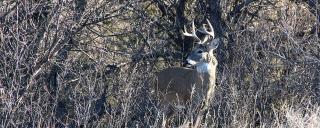
White-tailed Deer
General Information
White-tailed deer are the most abundant big game species in North America. They are most common in forested areas associated with farmland. Historically in North Dakota they were restricted primarily to the major riparian areas and wooded buttes. Introduction of the trade rifle and subsistence hunting dramatically reduced deer numbers throughout the region by 1860. The rush of European settlement in the 1870s and 1880s and subsequent subsistence and market hunting nearly extirpated all big game from the state by 1890. With the influx of annual crop production, tree rows and regulated hunting, white-tailed deer numbers have dramatically increased throughout North Dakota.
White-tailed deer populations rebounded and flourished across the west during the 1950s and early 1960s after improvements in habitat management, regulation of hunting and stricter law enforcement.
General Habitat Requirements
White-tailed deer are highly adaptable in their use of food and cover. They are opportunistic concentrate feeders. Depending upon the season, they will eat the palatable portions of a wide variety of sedges, grasses, forbs and browse. They will also feed on all species of domesticated crops grown for human and livestock consumption. Planted or naturally forested cover provides both browse and secure bedding sites. Open areas provide a variety of forage plants within reach of all deer age classes. Water is rarely a limiting factor for deer.
Management Considerations
- During the fawning season in June, use flushing bars, avoid night mowing and mow hay fields from the center outward.
- Fencing cattle out of forested areas and abandoned farmsteads provides secure fawning and bedding areas for white-tailed deer.
- Multi-row or block tree plantings provide winter cover by blocking the wind and reducing snow depth.
- Preserve native prairie. It is not recommended to convert native prairie for wildlife food plots, introduced grass species, trees, etc.
- Dense cattail stands and CRP fields can provide cover for deer during winter, provided they are large enough not to fill in with drifting snow.
- Food plots planted close to bedding cover, but away from stored livestock feed and major roads or highways, may alleviate some depredation problems.
- Do not leave hay bales in the field. Stack hay in accessible areas where they can be fenced and monitored. Put alfalfa and the most palatable hay in the center or on top of the hay stacks. Fence off and gate silage pits.
- Do not start an artificial feeding program, such as feeders, bait stations, corn piles, etc. Five to 10 deer at a feeder can quickly turn into 50 to 100 deer and a much larger management problem.
- The only way to realistically control deer numbers is through regulated hunting and an adequate harvest of does from the population.
Note: More information on whitetail habitat needs can be found in the Farm and Ranch Guide to Developing and Maintaining Wildlife Habitat on the Northern Great Plains.
